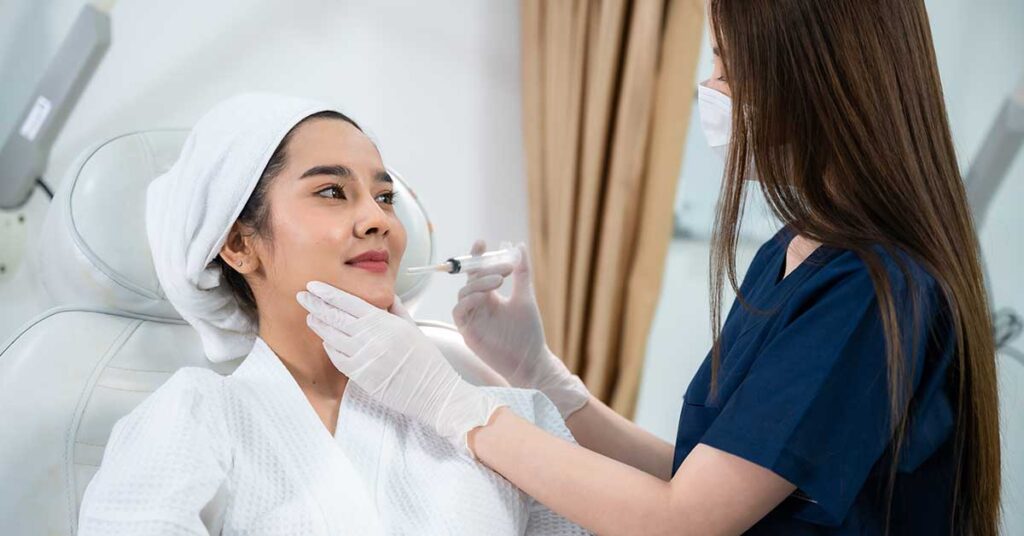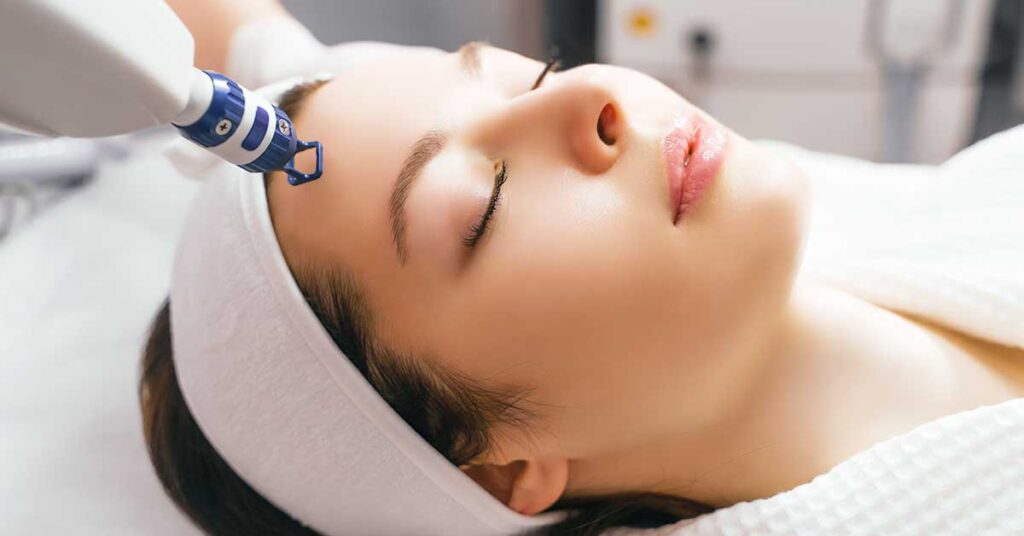Dr Elendrus Teo – Aesthetic Doctor In Singapore
Dr Elendrus Teo is an Aesthetic Doctor with expertise in clinical and surgical medicine at The Astique Aesthetic Clinic.
Learn more about anti-aging facial treatments like botulinum toxin and dermal fillers as well as laser treatments to achieve glass skin.
Table of Contents
Toggle
Botulinum Toxin is a neurotoxin that temporarily paralyses the muscles responsible for dynamic wrinkles, such as frown lines, crow’s feet, and forehead creases. By relaxing these muscles, botulinum toxin smoothes out wrinkles and prevents their further development. It is a popular choice for addressing fine lines and wrinkles associated with facial expressions.
Dermal fillers are injectable substances that restore lost volume, fill in wrinkles, and rejuvenate the face. The most common type of dermal filler is hyaluronic acid, a natural substance found in the skin that helps it retain moisture and suppleness. Dermal fillers can be used to plump lips, enhance cheekbones, fill in nasolabial folds, and improve the overall contour of the face.
There are several brands and types of botulinum toxin and dermal fillers available, each with specific formulations for various purposes. The choice depends on individual needs and goals.
The procedure for botulinum toxin and dermal fillers is relatively straightforward:
Consultation: Consultation with a qualified healthcare provider who specialises in aesthetic procedures to discuss the patient’s goals, concerns, and expectations.
Pre-Procedure: Depending on the aesthetic provider’s recommendations, the patient may be asked to avoid blood-thinning medications and alcohol before the treatment. It is advised for patients to arrive makeup-free during the appointment.
Procedure: During the treatment, the aesthetic provider will apply a topical numbing cream or use a local anesthetic to minimise discomfort. Botulinum toxin is injected into specific muscles, while dermal fillers are injected into targeted areas to restore volume or fill in wrinkles.
Post-Procedure: After the treatment, the patient may experience some mild redness, swelling, or bruising, which usually subsides within a few days. Most people can resume normal activities immediately.
How much botulinum toxin or dermal filler you may require is determined by evaluating your personal objectives for treating wrinkles and fine lines, as well as your medical history. The professional physician will assess the ability of your facial muscles to contract, for which you must first contact a doctor.
Before the procedure, inform your aesthetic provider about any allergies, medical conditions, or medications you are taking. Follow the pre-procedure instructions provided. Also remember to arrive at your appointment with a clean face, free of makeup and skincare products.
After your procedure, remember to:
The effects of Botox become noticeable over the course of several days to a week, as the treated muscles gradually relax, leading to smoother skin and reduced wrinkles. The results are not permanent and typically last around three to four months, after which follow-up treatments may be needed to maintain the desired outcome.
For Dermal fillers, the result of the treatment is usually visible immediately, with enhanced volume and smoother skin. Depending on the type of filler used and individual factors, the effects can last anywhere from several months to over a year. Subsequent sessions might be necessary to maintain the desired outcome.
While botulinum toxin and dermal fillers are generally safe when administered by trained professionals, there can be potential side effects, including:
The cost of botulinum toxin and dermal fillers may vary depending on the brand used, the number of areas needed to be addressed, and the location. Botulinum toxin in Thailand may cost S$6 and above per unit. For dermal fillers, it may cost S$260 for 1cc and above.

“Glass skin” is a term that originated in South Korea and has become popular in the world of skincare and beauty. It refers to a type of facial treatment and skincare routine that aims to achieve exceptionally smooth, clear, and radiant skin that resembles the appearance of glass or porcelain. Glass skin is characterized by a dewy, luminous complexion with minimal visible pores, blemishes, or imperfections.
Laser treatments can be effective for achieving glass skin by addressing various skin concerns such as pigmentation, uneven texture, fine lines, and acne scars. Here are some common types of laser treatments that can help you achieve a smoother and more radiant complexion:
1. Fractional Laser Resurfacing: Fractional laser treatments, like fractional CO2 and fractional erbium lasers, create tiny, controlled micro-injuries in the skin, stimulating collagen production and promoting skin rejuvenation. They can be effective for improving skin texture, reducing fine lines, and minimizing the appearance of scars and pigmentation.
2. IPL (Intense Pulsed Light) Therapy: IPL treatments use broad-spectrum light to target various skin issues, including sun damage, redness, and pigmentation. IPL can help even out skin tone and improve overall skin clarity.
3. Q-Switched Nd:YAG Laser: This laser is commonly used for treating pigmentation issues such as melasma, freckles, and age spots. It works by breaking down melanin deposits in the skin, leading to a more even complexion.
4. Non-Ablative Laser Therapy: Non-ablative lasers, such as the fractional non-ablative laser, stimulate collagen production without causing significant damage to the outer layer of the skin. These lasers can help with skin tightening, reducing fine lines, and improving skin texture.
5. Ablative Laser Resurfacing: Ablative lasers, such as the CO2 laser, remove the outer layer of the skin to promote new skin growth. While they can provide dramatic results in terms of skin rejuvenation, they often require a longer recovery period and may not be suitable for all skin types.
6. Clear + Brilliant Laser: This is a gentler fractional laser treatment that targets early signs of aging and uneven skin texture. It can help improve skin tone, reduce the size of pores, and enhance overall skin radiance.
7. PicoSure Laser: PicoSure is a picosecond laser that can target various skin concerns, including pigmentation, acne scars, and wrinkles. It delivers laser energy in ultra-short pulses, which can result in minimal downtime compared to some other laser treatments.
8. Venus Viva: Venus Viva is a non-ablative radiofrequency (RF) device that can help improve skin texture, reduce wrinkles, and diminish scars. It works by heating the deeper layers of the skin, stimulating collagen production.
9. Fraxel Laser: Fraxel is a fractional laser treatment that can address a range of skin concerns, including fine lines, scars, and pigmentation issues. It promotes collagen production and skin renewal.
Before undergoing a laser procedure aimed at achieving “glass skin,” thorough pre-procedure preparation is essential to maximize its effectiveness and safety. In the weeks leading up to the procedure, prioritize sun protection by diligently applying broad-spectrum sunscreen with SPF 30 or higher and avoiding excessive sun exposure. Discontinue the use of skincare products containing retinoids, alpha hydroxy acids (AHAs), or beta hydroxy acids (BHAs) as directed by your aesthetic provider, usually a week or more before the procedure. Ensure your skin is clean and free of makeup on the day of the procedure.
\ Immediately following the treatment, your skin may be sensitive, and you may experience redness and mild swelling. It’s crucial to follow your provider’s instructions for post-procedure care, which often include applying a soothing, hydrating topical product and avoiding harsh skincare products, including retinoids and AHAs, for a specified period. Protect your skin from sun exposure by wearing a wide-brimmed hat, sunglasses, and using broad-spectrum sunscreen with at least SPF 30, even on cloudy days. Stay well-hydrated, drink water, and maintain a gentle skincare routine to nurture your healing skin.
Over the following weeks, you’ll gradually notice improvements in skin texture and tone as your skin continues to rejuvenate. Regular follow-up appointments with your aesthetic provider can help assess progress and adjust your skincare regimen as needed, further supporting your journey to achieve and maintain the coveted glass skin appearance.
Laser procedures for achieving “glass skin” can be highly effective, but like any medical or cosmetic procedure, they carry the risk of potential side effects. The specific side effects can vary depending on the type of laser used, your skin type, and how well you follow pre- and post-procedure care instructions. Here are some common potential side effects:
The cost of lasers for glass skin may vary depending on the laser used, the number of areas needed to be addressed, and the location. It may cost S$100 and above.
Dr Elendrus Teo is an Aesthetic Doctor with expertise in clinical and surgical medicine at The Astique Aesthetic Clinic.
Dr Kenneth Lee is an aesthetic doctor in Singapore and the Medical Director at Dr Plus Aesthetics Clinic. Learn more about Mr Lee.
Health365 Aesthetic can help you make the right decisions when it comes to facial treatments. We have trusted and reliable medical partners to guide you on your enhancement journey. For any questions, inquiries, or concerns, reach us through the button below.
Further Reading That Might Interest You
In this article, we list 5 Bangkok aesthetic clinics and hospitals that are worthy of your attention and consideration.
Getting Botox in Thailand is an option to consider. Thailand is a medical tourism hub offering quality yet affordable aesthetics.
We noticed you are visiting from .
Please select the language in which you would like to see the content.